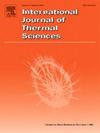Advancing thermal radiation efficiency with hybrid-patterned metasurface emitters in thermophotovoltaic systems
IF 4.9
2区 工程技术
Q1 ENGINEERING, MECHANICAL
International Journal of Thermal Sciences
Pub Date : 2025-02-24
DOI:10.1016/j.ijthermalsci.2025.109790
引用次数: 0
Abstract
In thermophotovoltaic systems, it is essential for emitters to effectively convert thermal energy into thermal radiation photons within the useable wavelengths for photovoltaic cells. Metasurface emitters enable broadband emission to efficiently and accurately match photovoltaic cells because of their complex optical properties and adjustable resonance behavior. In this study, a hybrid-patterned metasurface emitter was designed using an inverse neural network and optimized by a genetic algorithm to efficiently match InGaAs cells with different bandgaps. The designed hybrid-patterned metasurface emitter exhibits 90% high in-band emission with near-zero out-of-band emission, and it is angle insensitive and polarization independent. The optical performance of the emitter and the output performance of the radioisotope thermophotovoltaic system were studied at temperatures ranging from 700 K to 1300 K. At 1300 K, the emitter demonstrates an effective spectral efficiency of 69.84%. The radioisotope thermophotovoltaic system with a 0.56 eV InGaAs cell has a maximum output power density of 1.16 W/cm2 and an energy conversion efficiency of 20.77%. The mechanism of selective emission was elucidated. Finally, the hybrid-patterned metasurface emitter was fabricated by micro-nano fabrication technology, and its performance was studied. The optimization and fabrication of the hybrid-patterned metasurface emitter provide an important theoretical foundation and practical guidance for enhancing thermal radiation efficiency.
求助全文
约1分钟内获得全文
求助全文
来源期刊

International Journal of Thermal Sciences
工程技术-工程:机械
CiteScore
8.10
自引率
11.10%
发文量
531
审稿时长
55 days
期刊介绍:
The International Journal of Thermal Sciences is a journal devoted to the publication of fundamental studies on the physics of transfer processes in general, with an emphasis on thermal aspects and also applied research on various processes, energy systems and the environment. Articles are published in English and French, and are subject to peer review.
The fundamental subjects considered within the scope of the journal are:
* Heat and relevant mass transfer at all scales (nano, micro and macro) and in all types of material (heterogeneous, composites, biological,...) and fluid flow
* Forced, natural or mixed convection in reactive or non-reactive media
* Single or multi–phase fluid flow with or without phase change
* Near–and far–field radiative heat transfer
* Combined modes of heat transfer in complex systems (for example, plasmas, biological, geological,...)
* Multiscale modelling
The applied research topics include:
* Heat exchangers, heat pipes, cooling processes
* Transport phenomena taking place in industrial processes (chemical, food and agricultural, metallurgical, space and aeronautical, automobile industries)
* Nano–and micro–technology for energy, space, biosystems and devices
* Heat transport analysis in advanced systems
* Impact of energy–related processes on environment, and emerging energy systems
The study of thermophysical properties of materials and fluids, thermal measurement techniques, inverse methods, and the developments of experimental methods are within the scope of the International Journal of Thermal Sciences which also covers the modelling, and numerical methods applied to thermal transfer.
 求助内容:
求助内容: 应助结果提醒方式:
应助结果提醒方式:


